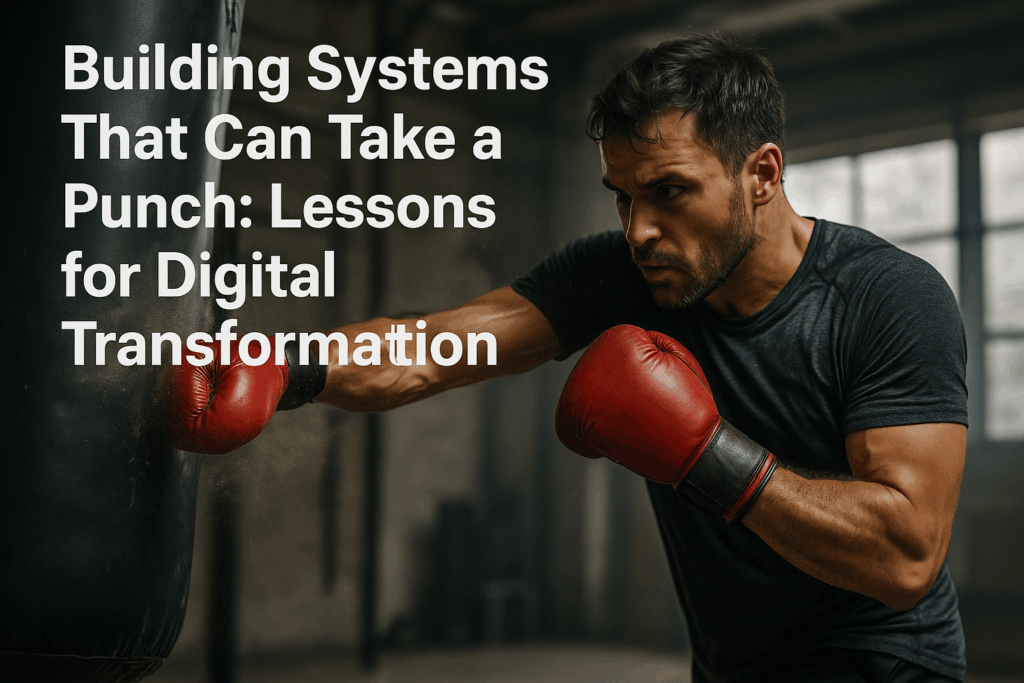
At Digital Transformations LLC, we constantly remind clients that building great technology isn’t just about speed, it’s about resilience. In the military, strategists talk about the need to “take a direct punch in the nose” and still come back swinging. In business and tech, the same lesson applies. Whether the punch comes from a sudden outage, a cyberattack, or a disruptive market shift, organizations need the ability to absorb the blow, adapt quickly, and keep delivering.
DevOps as Digital Defense
DevOps has always been about shortening the feedback loop, but too often organizations treat it simply as faster pipelines. The deeper value is defensive, by integrating monitoring, automated recovery, and chaos engineering into daily practice, DevOps teams build the reflexes to withstand failures. It’s not a matter of if systems will fail, but how fast you can detect, isolate, and restore them. A resilient DevOps culture sees every “failure” as training for the next inevitable hit.
Lean|Agile and the Discipline of Adaptation
Lean and Agile practices extend this resilience into the organizational layer. Just as NORAD wrestles with finite resources across competing theaters, businesses face similar constraints with budget, talent, and time. Agile doesn’t magically make those limits disappear. What it does is force teams to prioritize continuously, adapt their plans in real time, and avoid overcommitting to strategies that crumble under stress. The organizations that thrive are those that keep their operational playbooks light enough to pivot, but principled enough not to drift with every gust of change.
Golden Dome and the Myth of 100% Protection
We’re watching the same conversation play out with “Golden Dome” missile defense. One that promises perfect protection, but reality demands tradeoffs. The same is true in IT security and transformation projects. No system can be shielded from every exploit, phishing attack, and hack. You need to be proactive in your security. The smart move is not to build an illusion of invulnerability, but to design layered defenses, clear escalation paths, and recovery mechanisms. Resilience isn’t about intercepting every strike, but it’s about making sure no single hit takes you off line.
Data, Detection, and Domain Awareness
Military leaders point to gaps in Arctic radar coverage as a national security risk. In digital systems, our equivalent is observability. You can’t defend what you can’t see. Too many enterprises still treat logging and monitoring as afterthoughts, but in reality, metrics, traces, and real-time anomaly detection are the radars of digital transformation. Without them, threats slip by unnoticed until they’ve already done damage. The organizations that endure are the ones that make detection, not just prevention, the core of their strategy.
Building a Culture of Resilience
Ultimately, technology choices are just the scaffolding. The foundation is culture. We see it time and again where organizations that celebrate speed at all costs burn out their teams and leave themselves brittle. Those that emphasize learning, disciplined experimentation, and mutual trust with cross functional teams, transparency and communication, create the conditions for long term survival.
The Takeaway
At Digital Transformations LLC, we believe resilience is the real competitive advantage in a world of uncertainty. DevOps provides the reflexes. Lean/Agile gives the adaptability. And a disciplined approach to security, data, and culture ensures the ability to take a punch and keep moving forward.
In a time when threats, technical, economic, or geopolitical are multiplying, the organizations that thrive will be those that accept vulnerability as inevitable, but refuse fragility as an option.
